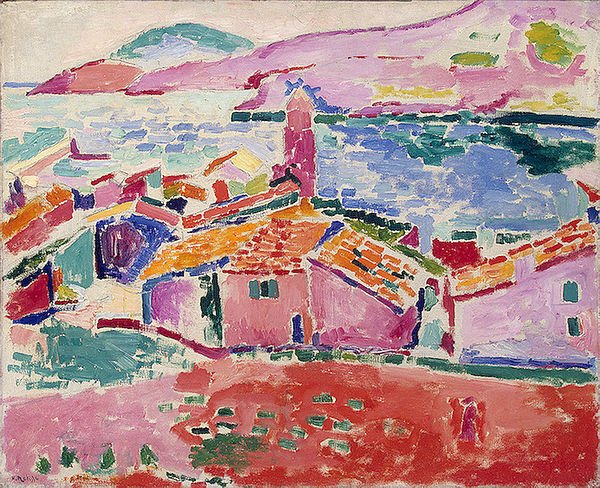The Move Towards the Interior, Matisse and the Fauves
Words by Emily Quli
Matisse, the “master of colour” was constantly in movement. He was a prominent figure amongst the Fauves - The Wild Beasts. These beasts were happily destroying the simplicity and security that traditional realism had given. They were tearing it apart with emotion and feelings as they pioneered a move towards the interior. In fact, their work is the foundation of modern art as they began to understand that art is an expression of the emotion that the artist is feeling. The increasing popularity of photography meant that there was no longer a limitation for art to represent real objects. Their paintings are full of animation, life and as a consequence – emotion.
Henri Matisse: Open Window, Collioure (1905)
Camille Mauclair, a renowned art critic, said that “a pot of paint has been flung in the face of the public” after seeing Matisse’s works at the Salon d’Automne in 1905. The paint Matisse threw has struggled to get out of the public's eyes ever since. The movement has opened the public to a new perspective of excitement and flamboyance that is removed from artistic traditions. It shows that art can bend the rules and move towards the interior place where art comes from - Affect.
Press clipping, Les Fauves: Exhibition at the Salon d'Automne, in L'Illustration (4 November 1905)
The Fauves were given their name after the Salon d'Automne 1905, yet they were mostly bound together by friendship rather than artistic discipline. Grouping together became a solidarity amongst the pioneering rebels. They are Wild Beasts, erratic, aggressive animals that leap from their paintings and cause a complete disruption to the tradition and acceptance of realism. What distinguishes their work is their distortion of natural colour, they deliberately choose anti – natural hues. They also have an interest in intensifying the effect of the lighting through their paintings. Theoretically they created an “optical mixture” through their realisation of how luminosity can be initiated and also by replacing shadowed areas with the relationship of closely related hues. This creates optical vibration as a consequence. The potency of their colours is a result of “movement”. Seigworth comments that “affect arises in the midst of ‘in-between-ness’: in the capacities to act and be acted upon.”. It is this very ‘in-between-ness’ of the Fauves’ optical mixtures that creates the emotion and life that is planted on their canvases, providing an outlet for emotion to “act and be acted upon”. Their bold colours and pretence of imprecision creates a movement on the canvas that hadn’t been done before.
Henri Matisse, Les toits de Collioure (1905)
Matisse started a wave of emotion, his unorthodox works opened up a new perspective of creating art. It starts from private regulations that the artist decides for themselves. The subjectivity and feelings through his work create movement as they move the observer into themselves to contemplate what his works mean for them – for once they are not told how to think. Matisse was first trained as a lawyer and took up painting in 1890 studying under Moreau at the Ecole des Beaux- Arts. He worked frequently in the Mediterranean and French Riviera but began to explore colour more confidently during his stay in Corsica. His gradual move from the Impressionist influence developed from his experience of the light of the south which transformed his works. It was his time in Toulouse when he began to use brushwork with liberation, abstaining from organisation. His ‘messy’, ‘childlike’ approach to painting is really just an outpour of the freedom of his movement. When he stayed with Derain at Collioure in the summer of 1905 he stopped using broken brushwork and contrasts of complimentary colours that he had developed from the Neo – Impressionist tradition. He turned to the flat planes of anti-natural colours, an abrasive and bold move. Despite the consistent criticism of his works and expressions it just moved Matisse to work from his interior feelings and emotions as opposed to the rigorous, exterior opinions of others. He moved past them and instead redirected and aligned his ambitions with what he loved to do, not what others loved to see. As Seigworth comments, Affect is “at once intimate and impersonal”. Matisse uses the intimacy of his emotions and feelings to create a piece of art given to the public which immediately becomes impersonal.
Andre Derain, Landscape near Chatou, (1904)
La Femme Au Chapeau is the first notable division from tradition. It is a portrait of his wife Amelie Parayre. The painting itself has elements of French Bourgeoisie and conventions such as the gloved arm holding a fan and the elaborate hat on top of her head. There are many differences between this painting and traditional portraiture. The brightness and colourfulness is the obvious distinction. The critics found this colourfulness vulgar but it adds a playful bashfulness to the painting that makes his tender feelings towards his wife obvious. Rather like Impressionism, the painting only makes sense when working together as a whole. The hat on a closer look for example appears to be an accumulation of unfinished paintings. Each part of the decoration is fighting each other for attention. It is this unresolved tension and conflict in the painting which results in its movement.
Henri Matisse, La Femme Au Chapeau (1905)
Affect is then found in the radical movement of the works and within the works of the Fauves. Their use of colour is the vehicle for this emotion. It is their raw feelings which makes these paintings harsh, aggressive and loud as they are a purge of the personal emotions that the artists were feeling. Thinking back upon what Camille Mauclair said, I can’t help but feel that not only did they fling paint in the faces of the public but also their emotions. This is what helps us to see the paintings with the feeling and affect that they were charged with.





